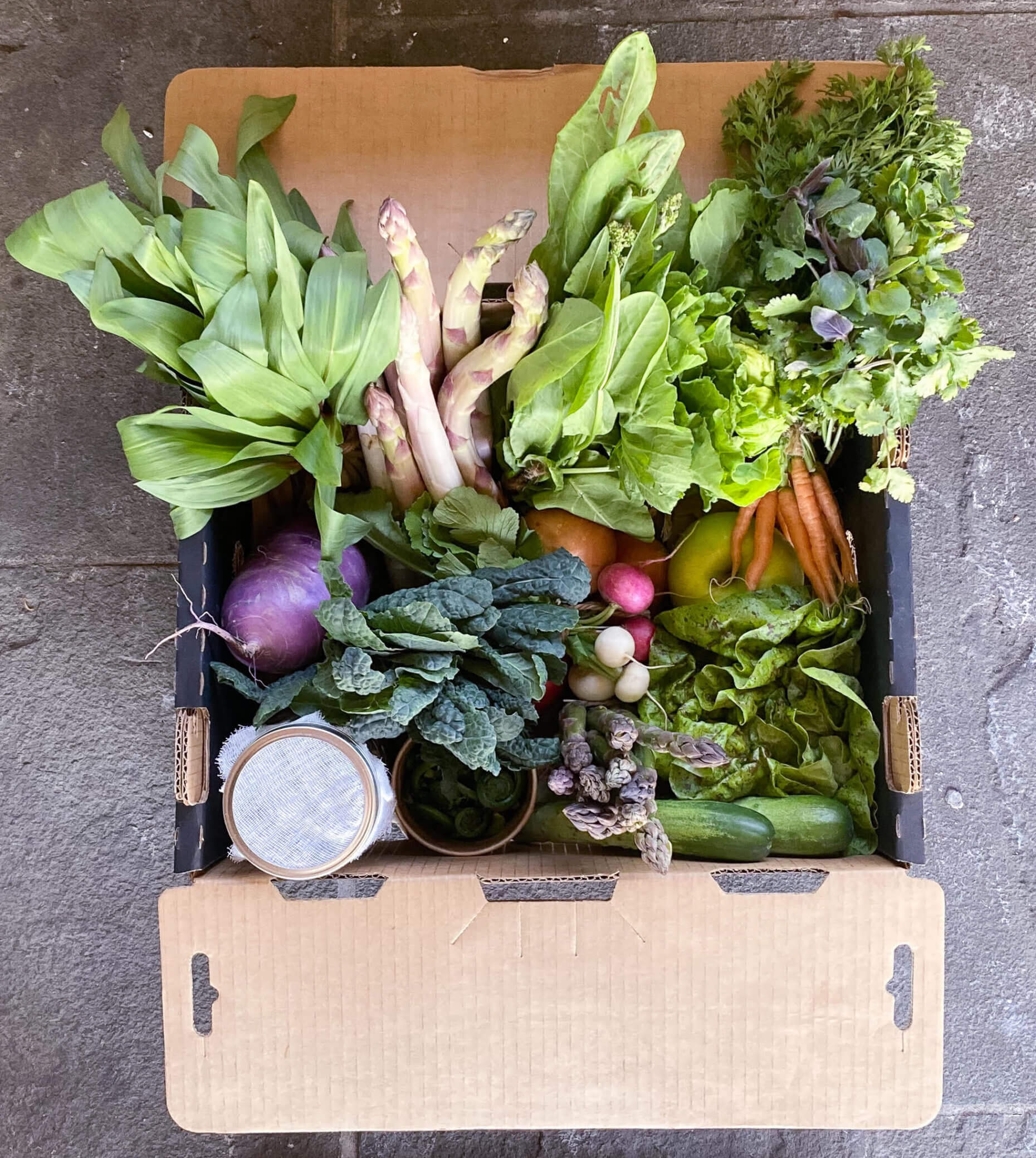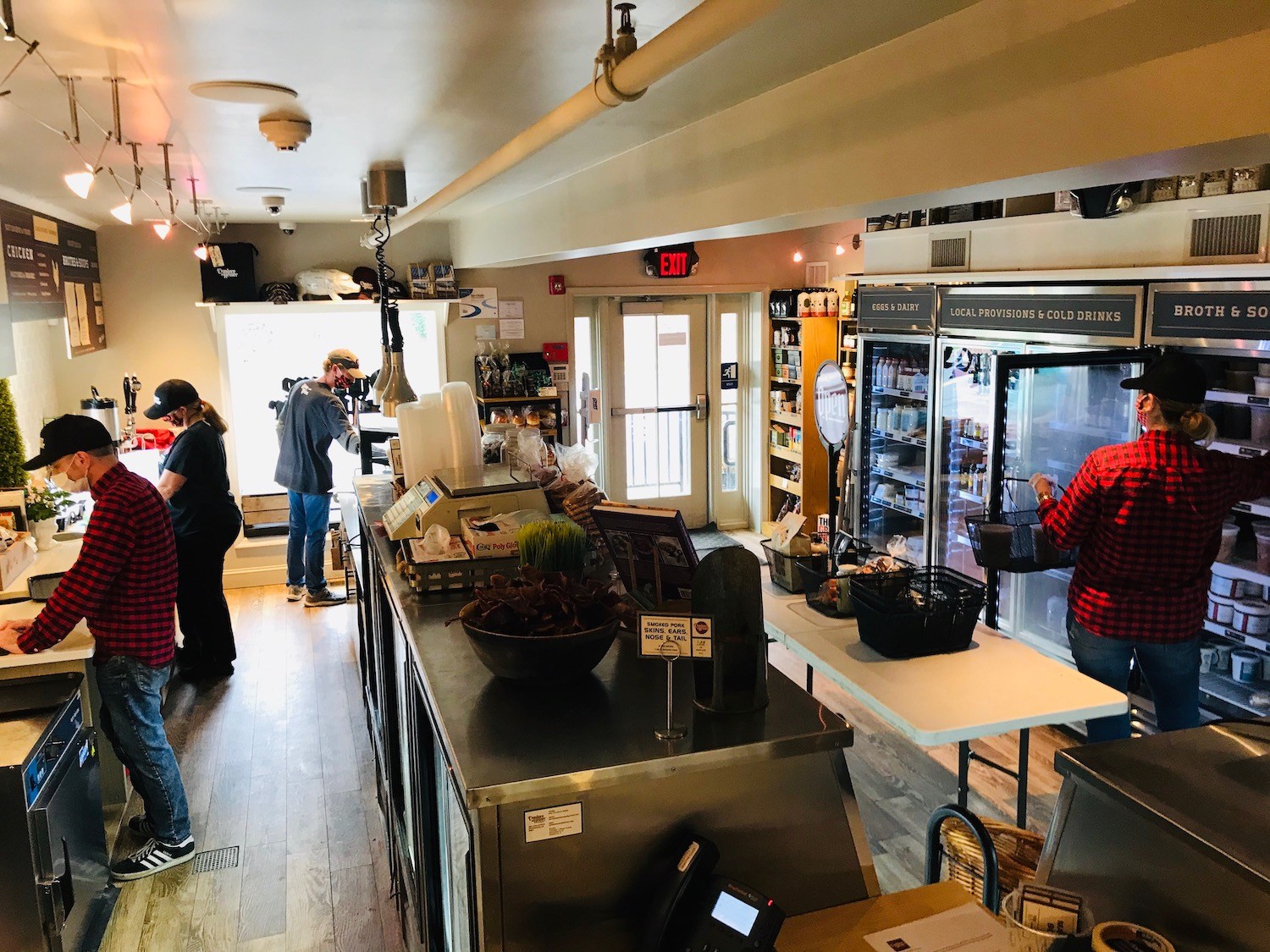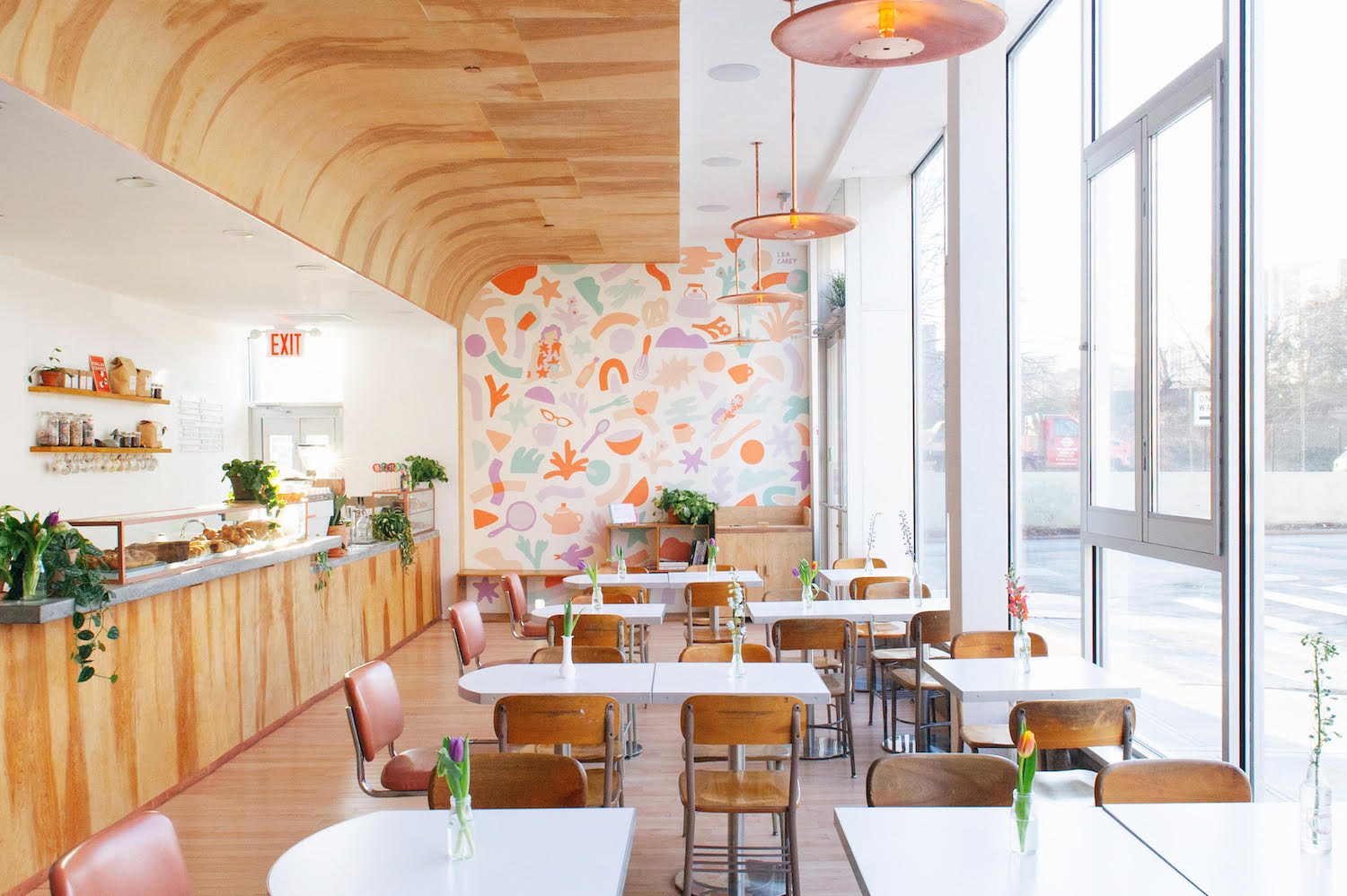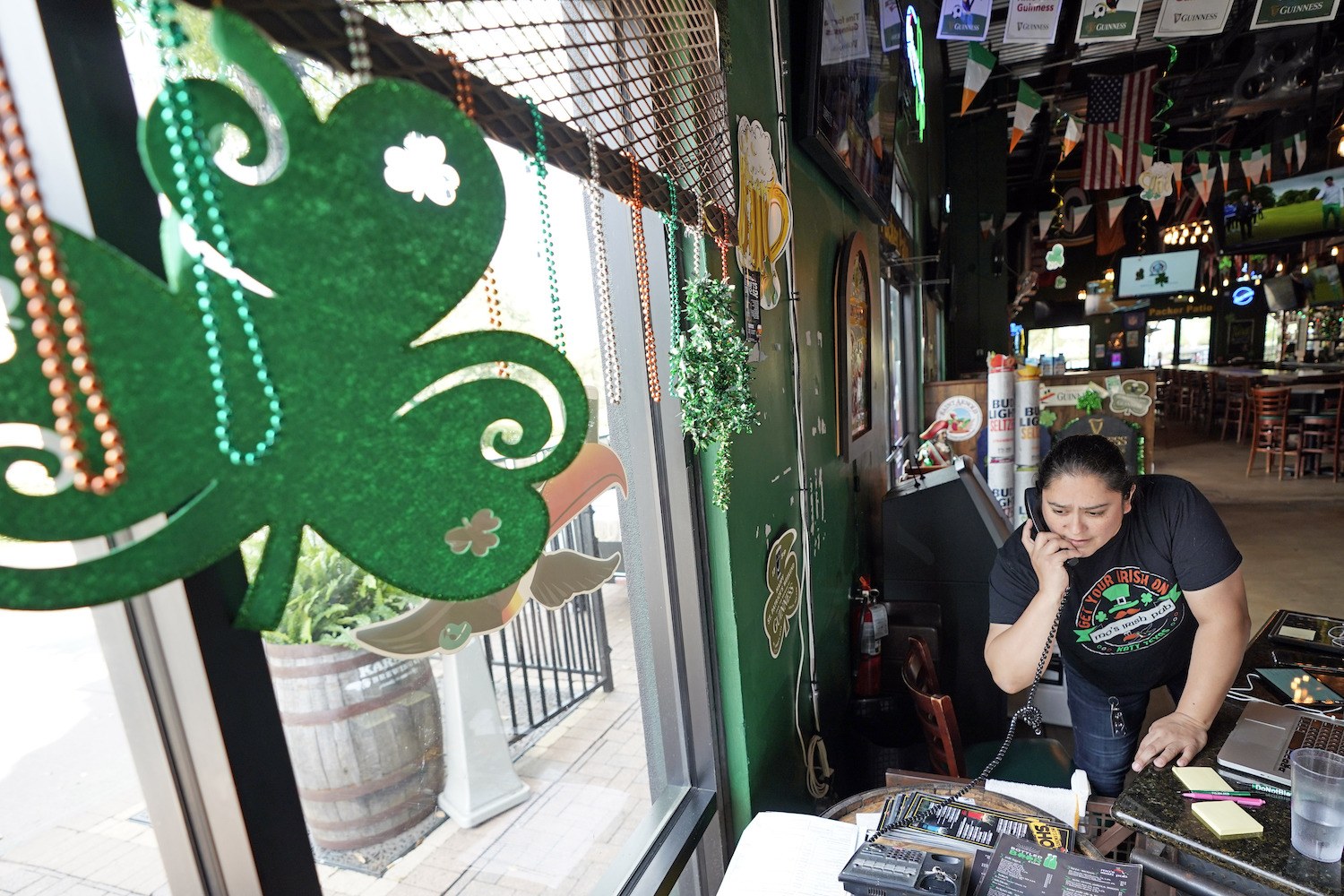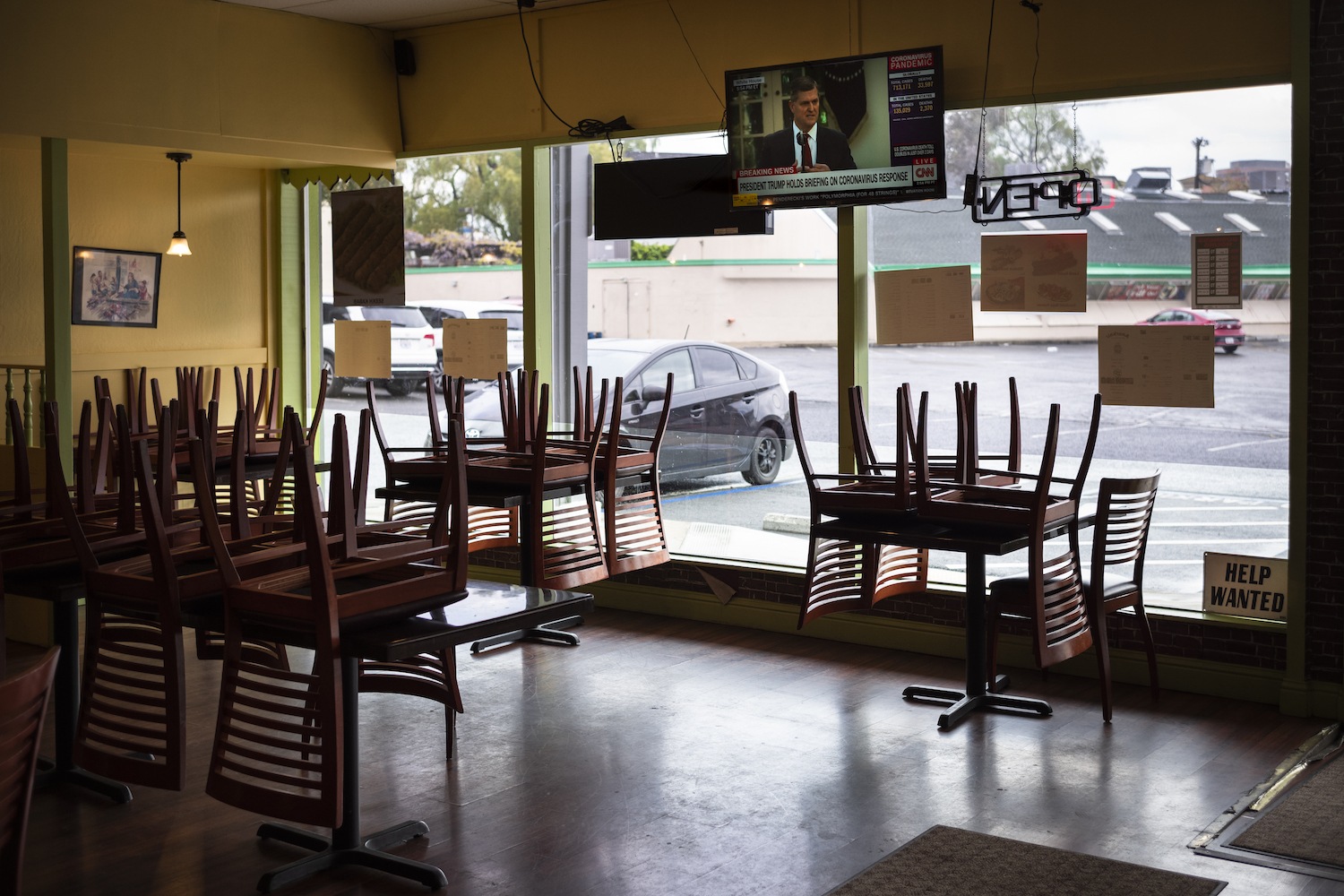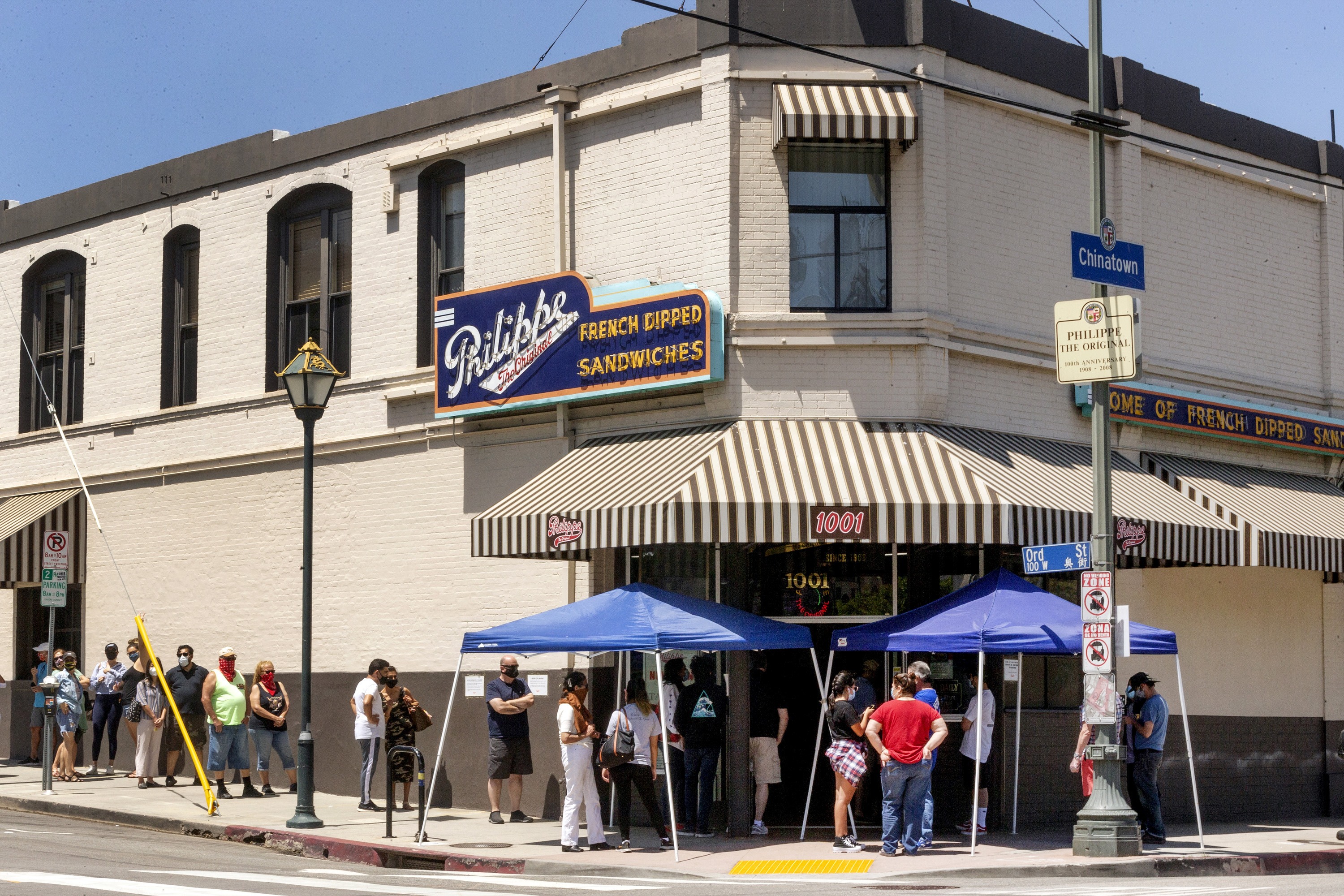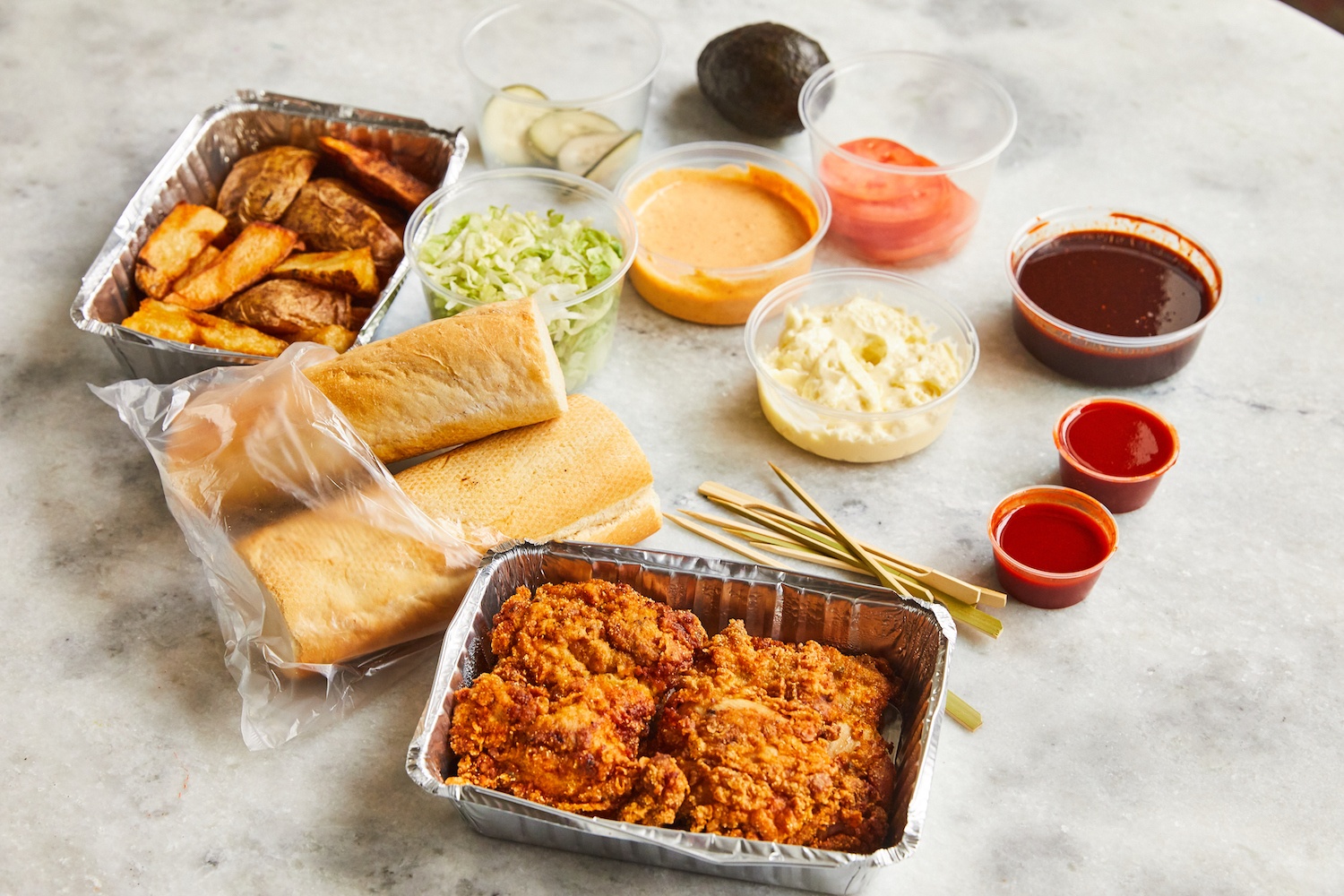
Heather Talbert
They were pitched as a way to help struggling restaurants. Are meal kits the future, or are they simply a stopgap?
Chicago whole-animal restaurant Frontier, which used to be a 130-seat, two-story restaurant, looks more like an oversized take-out operation these days. Stacks of carryout containers line the handsome bar, and a central row of dining room tables acts as a makeshift assembly line for filling meal kit orders, along with about 1,000 weekly meal donations distributed to community organizations.
Meal kits began as a desperation move. When Illinois’s governor issued a statewide stay-at-home order on March 15 to curb the spread of Covid-19, executive chef and partner Brian Jupiter had to hustle to come up with a survival strategy; his ten-year-old place didn’t do take-out. Three days later, Frontier rolled out a to-go menu alongside a weekly series of family meal kits, like whole-smoked chicken and pulled pork sliders, priced at $44 for four people.
“We started putting together all these little packages and wanted to make them reasonable and creative, staying in the wheelhouse of smoking meats and group dining,” said Jupiter, whose Pioneer Tavern Group runs four Chicago restaurants and bars.
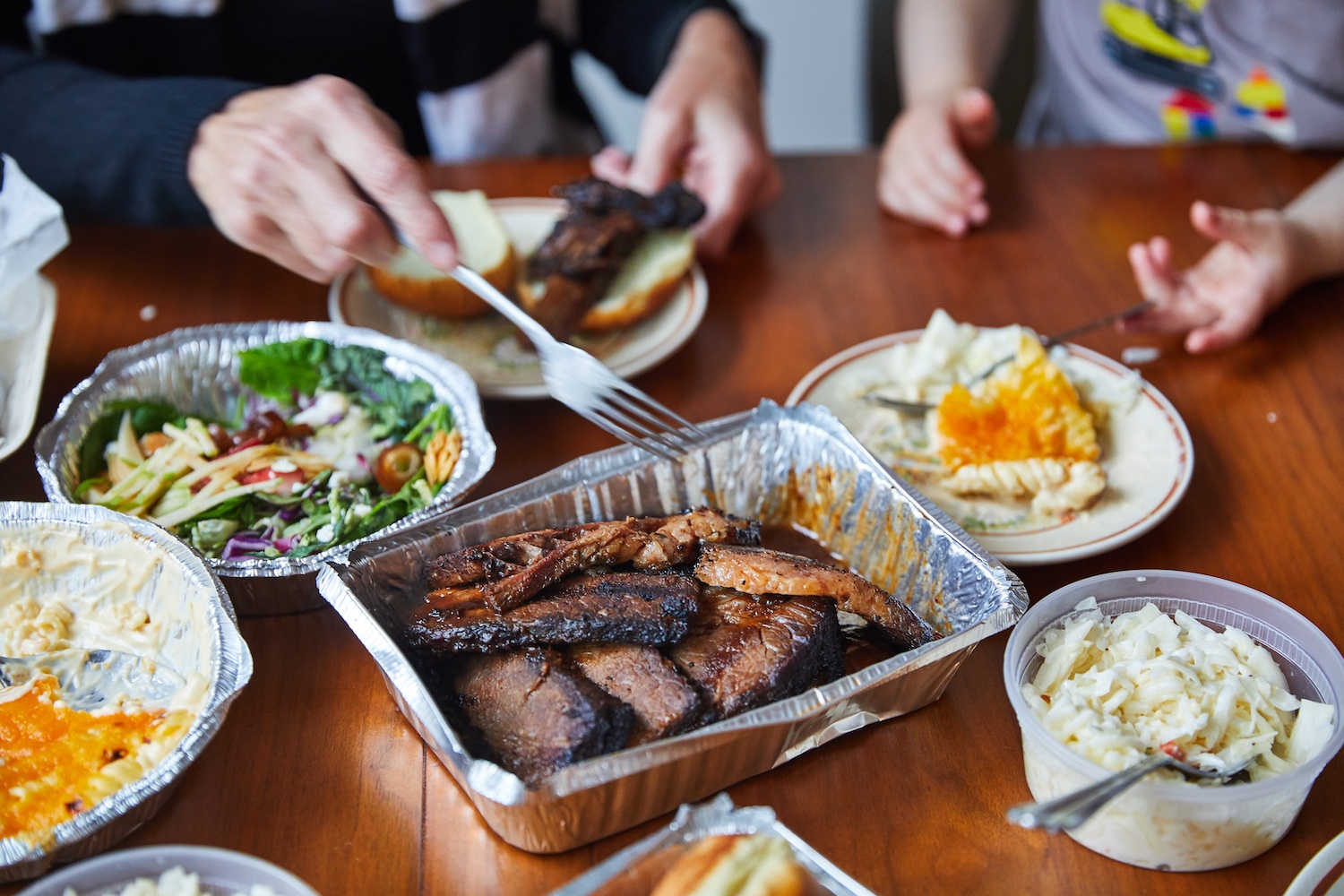
Frontier Smokehouse Sliders Kit 1
Heather Talbert
The kits took off, partly because they held up better than competing take-out offerings that couldn’t survive a 40-minute drive in a moisture-beaded takeout box. Since then, Frontier and its New Orleans-inspired sibling restaurant Ina Mae Tavern (which had a to-go business pre-Covid) rolled out kits featuring Jupiter’s gumbo ya-ya and chicken and biscuits, pairing some with live virtual cooking classes.
Right now, the kits are lifesavers for full-service restaurants that have seen an 80 percent decline in traffic, according to April data from NPD Group, a market analyst: Jupiter’s kits represented 70 percent of Frontier’s weekly sales in early June, and the two restaurants have hired back almost 40 staff members, without having to use the Paycheck Protection Program funds he received.
But one restaurateur has seen kit sales decline by two-thirds as restaurants start to reopen, as another redesigns his space to feature kits instead of table service. The only certain thing about meal kits, it seems, is their uncertain future.
“It looks like the desire to stay inside and avoid crowds, and still have a meal solution as people find themselves cooking more, helped the meal kit sector at least temporarily.”
They have had a rollercoaster history, whether purchased in-store or by subscription. The category exploded a few years ago; sales grew 22 percent in 2018 to reach roughly $3.1 billion, according to market intelligence service Packaged Facts. Yet cracks showed that year, as big players like Blue Apron and HelloFresh failed to turn a profit because of challenges with customer retention and the high costs of advertising, marketing, packaging and shipping.
Darren Seifer, executive director and food and beverage analyst for NPD Group, compares the category’s trajectory to the dotcom boom and bust of the early 2000s. “It’s been a whole lot of players jockeying for market share and not thinking about the bottom line,” Seifer said.
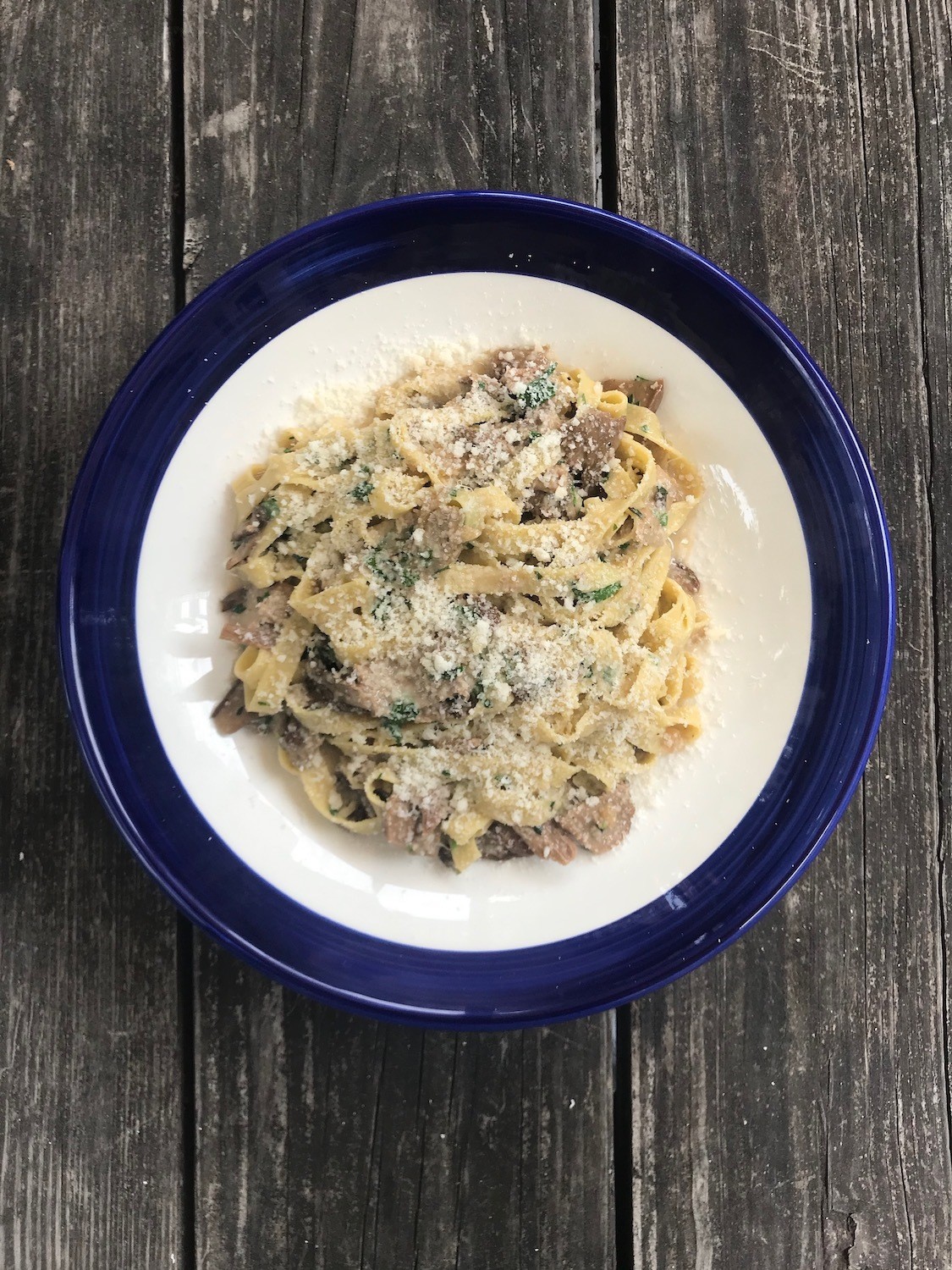
Chris McDade
Popina fettuccine porcini
In the months leading up to the pandemic, meal kits had flatlined—the number of U.S. adults who said they used one in the past month held steady at five percent, according to NPD.
“Then enter Covid, and all of a sudden, eight percent of consumers are using meal kits,” Seifer said, citing NPD ’s Covid-19 Pantry & Food Strategy Tracker. “It looks like the desire to stay inside and avoid crowds, and still have a meal solution as people find themselves cooking more, helped the meal kit sector at least temporarily.”
Brands with signature dishes have gotten into the act. Online gourmet food store Goldbelly has shipped items like Philadelphia’s Jim’s Philly cheesesteaks and New York’s Russ & Daughters’ bagels nationwide since 2013—but CEO Joel Ariel told Bloomberg that business is up 200 percent through mid-April, compared to last year, with order sizes up 30 percent. Fast-food chain Chick-fil-A rolled out $14.99 meal kits nationally in May, including chicken parmesan and lemony pasta for two; CNN reported that the company expects half its 2,363 locations to opt in.
Chris McDade, chef and owner of Popina, retooled his 34-seat Brooklyn restaurant to acknowledge the central role he believes meal kits will play. McDade was already mulling an expansion of his pasta brand into a brick-and-mortar shop, as well as a wholesale catering arm. When Covid-19 hit, he decided to make a more radical change, because occupancy limits would make it impossible to survive.
“We’re obviously sad that we can’t continue as what we set out to be, but also excited for the opportunity to do something different.”
“We started game-planning how we could keep Popina alive, because six feet of social distancing for us means about eight customers,” said McDade.
Cooked pasta doesn’t lend itself well to carryout, so McDade created the Pasta Project, do-it-yourself kits with fresh pasta and seasonal sauces for $14 to $16 per serving, with optional wine pairings. He produces 80 kits each week, which covers ingredients and a six-person staff.
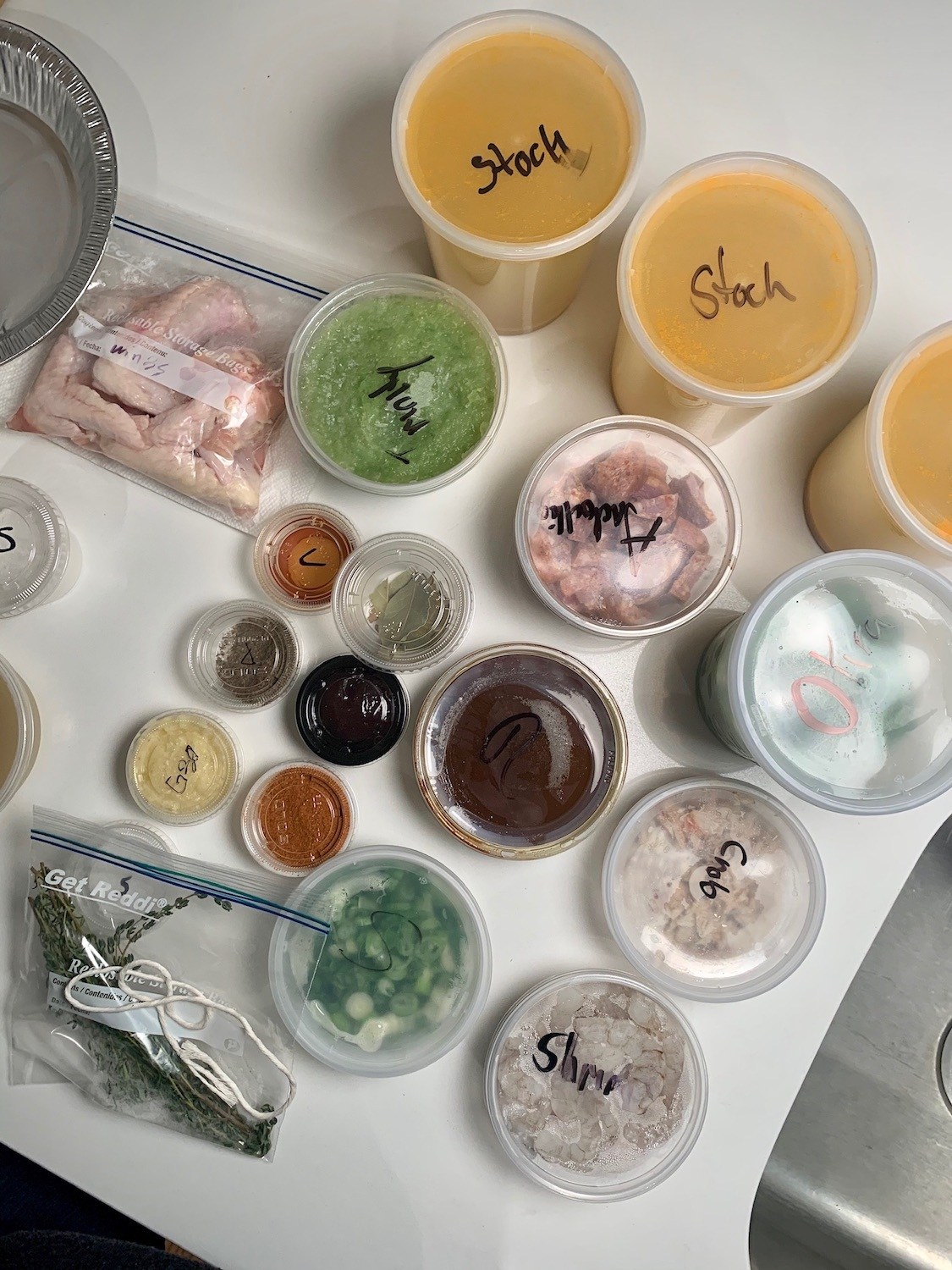
CLPR Photography
Ina Mae Gumbo Ingredient Kit 2
But the most dramatic change is in the space itself. All 34 seats are gone, as Popina morphs into a retail shop selling wine and imported provisions. McDade removed the counter seating along the front window to make way for a full-time pasta-maker to work in view of passersby. He tore out a banquette to add shelving for bottles of wine and amaro, an Italian herbal liqueur, and will install a refrigerated display of cheese, salumi and pasta.
The shop is open for pick-up and delivery. McDade plans to reopen the back patio as New York’s State Liquor Authority allows, on a model similar to Bacchanal in New Orleans, where customers buy a bottle of wine and open it onsite, with snacks on butcher paper-lined trays. The backyard can seat 50, though he hasn’t yet installed an awning. He’s heartened by the response so far: many new Pasta Project customers live in the neighborhood, but never knew Popina the restaurant existed.
“We’re obviously sad that we can’t continue as what we set out to be, but also excited for the opportunity to do something different,” he said.
Meal kits also play a key part in the dramatic shift Julia Sullivan has made, though she hasn’t yet determined the final structure of her business. The chef and owner of the Nashville seafood restaurant Henrietta Red, as well as the nine-month-old catering company The Party Line, closed the restaurant temporarily and, as catering cancellations mounted, turned the 4,000-sq.-ft. venue into a meal kit-delivery service, with a weekly or monthly subscription model. Although weekly sales are inconsistent, Sullivan’s rehired about half of her 60-person staff.
At 38 percent, the cost of ingredients and packaging is high, but Sullivan generates added income through specialty boxes for holidays and drop-off items like custom cakes.
“I had a realization that I didn’t want to spread the team too thin across two concepts,” Sullivan said. “We had momentum in The Party Line, so it seemed best to get everybody working in the same direction.”
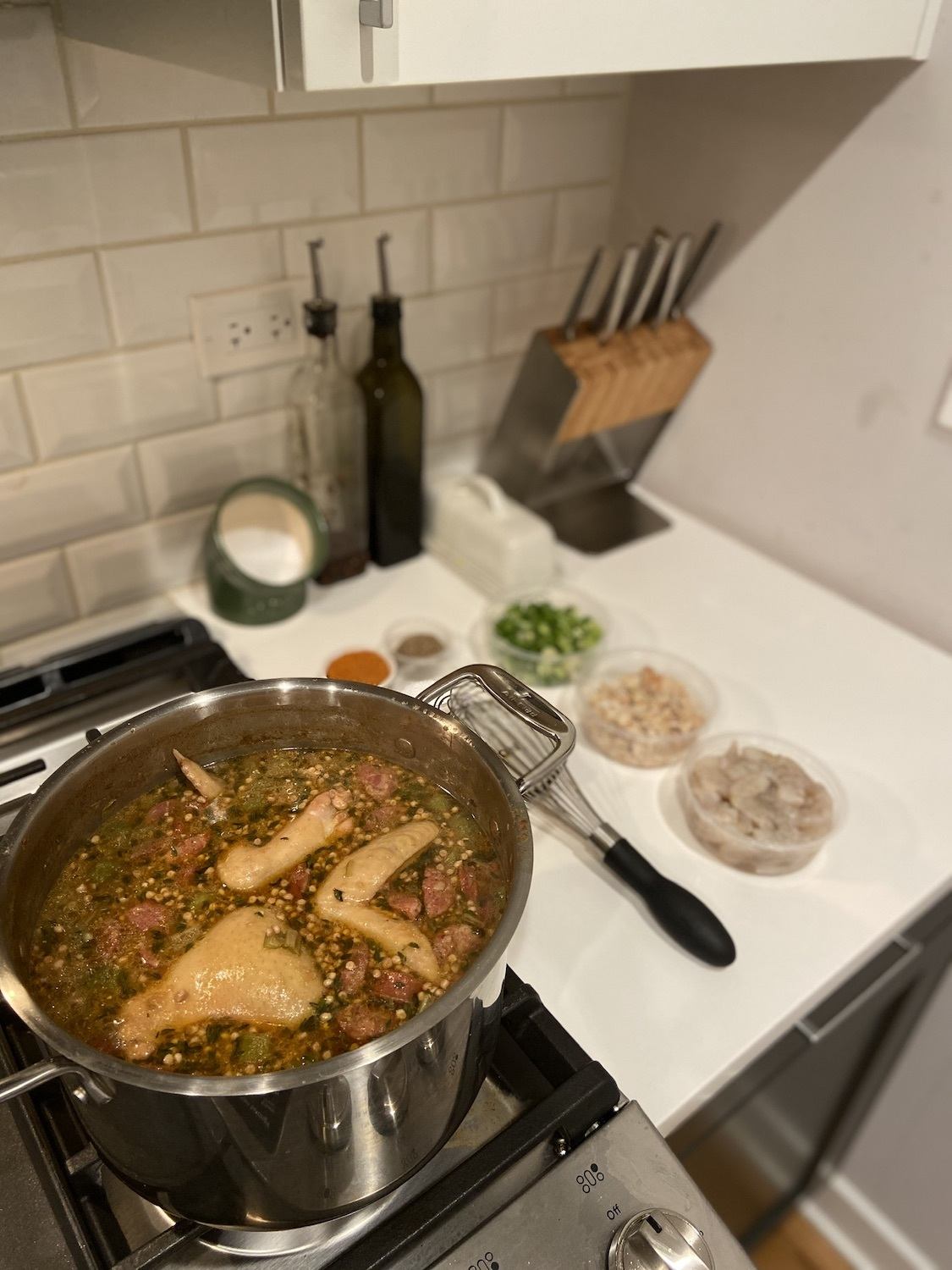
CLPR Photography
Ina Mae Gumbo Ingredient Kit 3
For the first six weeks, demand climbed sharply, until The Party Line had 175 weekly orders and a waitlist, with weekly sales of $25,000, about a third of pre-Covid weekly sales at Henrietta Red. Most of the customers were young professionals and senior citizens, so the team streamlined the menu to feature simpler offerings in small and large sizes. Sullivan bought routing software and hired two local farmers, who had been her suppliers, to to make the deliveries.
Meal kits start at $110 for four complete meals that each feed two or three, so that dinner ends up costing $9 per person; a typical offering might include a gochujang chicken entrée with roasted potatoes, or a pizza; two large salads with housemade vinaigrettes; and housemade bread and desserts. At 38 percent, the cost of ingredients and packaging is high, but Sullivan generates added income through specialty boxes for holidays and drop-off items like custom cakes.
As Tennessee edged toward reopening, kit subscriptions declined steadily, plateauing at around 65, but Sullivan sees that as a healthy foundation on which she can rebuild, alongside Henrietta Red, which reopened with takeout in early May and added patio and limited indoor dining in early June.
“If anything, people have expressed concern about catering, and also I’m enjoying this more than what we were doing before,” she said. “We’re going to try to focus on what is working, and I think this has a future.”
Full-service restaurants were struggling before the pandemic, as fast-casual enjoyed growing popularity, but Covid has given them a boost in traffic, ironically, as they transform their operations into grab-and-go models. They’re capturing 38 percent of the market (which doesn’t include convenience stores or supermarkets) compared to 17 percent in 2019, based on a survey of more than 5,000 consumers conducted by the data research firm Datassential and the International Foodservice Manufacturers Association.
“Right now it’s about providing solutions while people have to stay home, but can meal kit companies provide other conveniences that consumers find worth the spend?”
“Look at what grocery stores have already been doing—more and more are getting into the foodservice space, by offering meal kits, but also by having quick-service restaurants within retail,” Seifer said. Meal kits give restaurants a chance to compete for that part of the market.
Seifer doesn’t think the market for shortcuts is going anywhere, as long as people are eating at home. “People are making many more meals at home, but they don’t want to spend more time in the kitchen than they have to,” he said. “Meal kits answer not just what’s for dinner but how do I put this together?” But he can’t predict if they’ll survive a return to good health; users often cite cost as a reason to abandon them. “Right now it’s about providing solutions while people have to stay home, but can meal kit companies provide other conveniences that consumers find worth the spend?”
Jupiter is betting part of his future on home cooking momentum, even as he reopens Ina Mae and Frontier’s patios and window seating. He intends to keep the kits and cooking classes going—anticipating eat-at-home behaviors will survive long after there’s a vaccine. He’s considering a meal kit partnership with a local grocery store, which would discount ingredients in exchange for a slice of revenue.
“Customers can’t get that group dining thing out of their heads, and it’s honestly kept us going.”
His most popular kit is the wagyu ribs, at $42, though with food costs around $18 plus labor, it isn’t his most profitable. He makes more on the $52 seafood and chicken gumbo ingredient kit, at $12 to produce, plus labor. Some customers purchase multiple kits, distributing them to friends and family for simulcast Zoom dining.
“Customers can’t get that group dining thing out of their heads, and it’s honestly kept us going,” Jupiter said.
“I think this has changed people, the way they think and operate in some ways,” he said. “Some have truly gained some enjoyment with spending time with family at home, and creating these types of experiences with food and alcohol kits from restaurants. We taught them how to throw a little party at home.”

